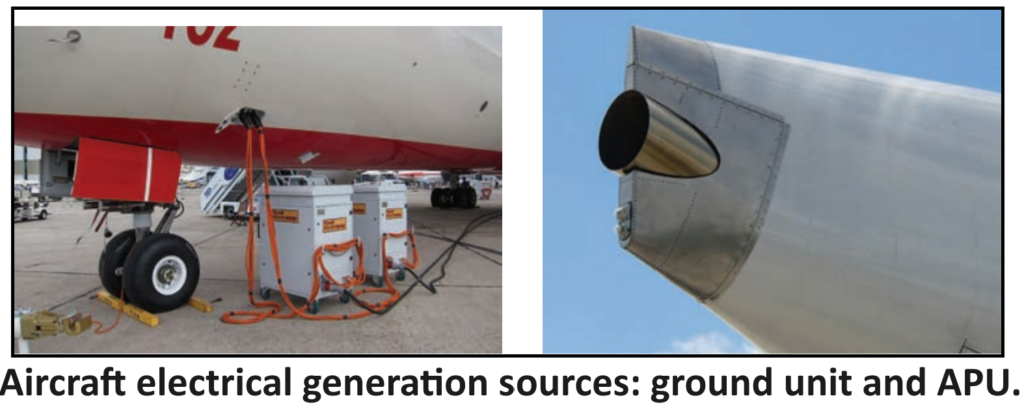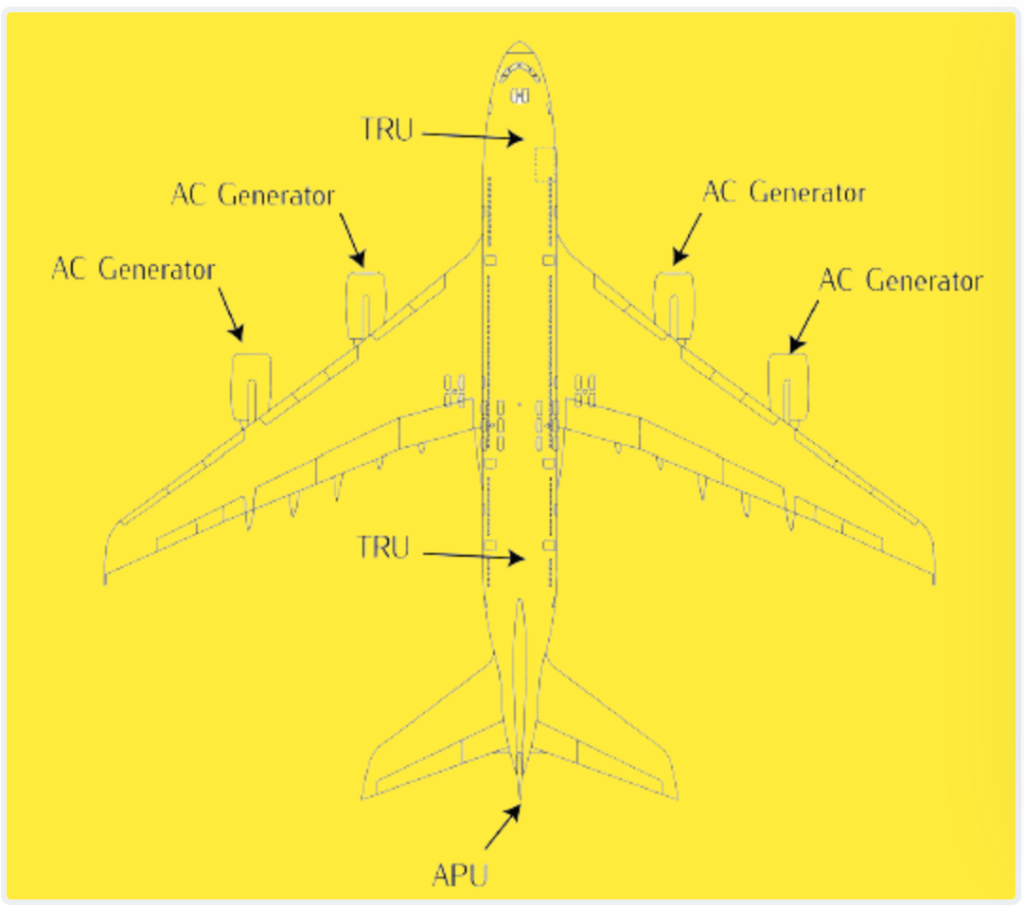An aircraft electrical system is a important component that provides power to various systems and instruments onboard.
Here is a comprehensive overview of the various components and functions of an aircraft electrical system. Let’s explain a bit deeper into each of these elements:
Power Generation Elements (AC Generation):
- Engine Driven AC Generators: These generators are typically connected to the aircraft engines and produce alternating current (AC) electricity as the engines operate.
- Auxiliary Power Units (APU): An APU is a small turbine engine located in the tail section of the aircraft. It can independently provide power to the electrical system, especially during ground operations or in-flight emergencies when the main engines are not running.
- External Power (Ground Power Unit – GPU): While on the ground, aircraft can be connected to external power sources via ground power units. This allows for electrical systems to be powered without using the aircraft’s own generators or APU.

- Primary Power Distribution and Protection (AC Distribution):
- Once generated, AC power is distributed throughout the aircraft via electrical buses. These buses ensure that power is routed to various systems and components as needed.
- Protection devices such as circuit breakers and fuses are installed to prevent overloads and short circuits, ensuring the safety and integrity of the electrical system.
- Power Conversion and Energy Storage (AC to DC and Storage):
- Since many aircraft systems and instruments require direct current (DC) power, AC power generated by the generators is converted to DC using transformers and rectifiers.
- Batteries are used to store electrical energy and provide backup power in case of generator failure or other emergencies.
- Secondary Power Distribution and Protection Elements (DC Distribution):
- DC power is distributed to various systems and components that require it, such as avionics, lighting, and electro-pneumatic mechanisms.
- Similar to AC distribution, protection devices are employed to safeguard against electrical faults and ensure system reliability.
- Redundancy and Backup Systems:
- Redundancy is very important in aircraft electrical systems to ensure continued operation in the event of component failure. Key elements such as generators, distribution systems, and backup power sources are often duplicated or even tripled for added reliability.
- Backup systems, including redundant generators, APU, and emergency power sources like ram air turbines (RAT), provide additional layers of safety and reliability in case of primary system failure.
By incorporating redundancy and backup systems, aircraft electrical systems are designed to maintain functionality and safety even in challenging conditions, contributing to the overall reliability of modern aircraft operations.
How does Aircraft Electrical System Works?
The engine-driven AC generators serve as the primary source of electrical energy in aircraft. Each engine propels an AC generator, harnessing the rotational energy of the turbine during normal flight operations. This generated power is important, supplying electrical energy to various systems and instruments throughout the aircraft. However, when the aircraft is grounded, the main generators closes operation, yet the need for electrical power persists for essential functions such as operational handling, maintenance tasks, and engine starting. In such scenarios, alternative energy sources must be tapped into to meet these demands.
One such alternative is the Auxiliary Power Unit (APU), a turbine engine positioned in the aft section of the aircraft fuselage. Primarily utilized on the ground, the APU functions as the primary electrical energy source during pre-flight preparations and maintenance activities. In-flight, the APU transitions into a backup power source, ready to engage should the primary generators encounter failure or require backup support.
Ram Air Turbines (RAT)
Additionally, certain aircraft are embedded with Ram Air Turbines (RATs), pivotal emergency backup components. Typically housed in the ventral or nose sections of the aircraft, RATs operate as air-driven turbines. In critical situations where conventional power generation methods falter, such as main generator or APU failure, whether in-flight or on the ground, RATs spring into action. Their deployment ensures the continuity of essential electrical power supply, safeguarding vital aircraft systems and instruments.
In essence, the integration of engine-driven AC generators, APUs, and RATs within an aircraft’s electrical system establishes a robust framework for power generation and redundancy. This comprehensive approach guarantees operational resilience, enabling aircraft to effectively navigate both routine operations and unforeseen emergencies with assured electrical power supply.
The aircraft’s electrical system encompasses not only the generation and distribution of AC current but also the crucial aspect of energy storage, particularly for emergency situations. While many aircraft systems operate on AC power, emergency energy storage requires DC power. Thus, an essential step in the process involves converting AC to DC, facilitated by transformation units.
Transformer Rectifier Unit (TRU)
Among the most prevalent methods of power conversion in modern aircraft electrical systems is the Transformer Rectifier Unit (TRU). This unit plays a pivotal role in converting the three-phase 115V AC current into 28V DC current, suitable for storage in batteries. These batteries serve as vital reservoirs of electrical energy, ready to be deployed in emergency scenarios.
Once converted to DC, the stored energy can be efficiently distributed through a secondary DC distribution system. This system serves dual purposes: supplying power to elements of the aircraft that specifically require DC input and facilitating emergency power supply when needed. Elements such as lighting, communication systems, and other critical components rely on this secondary DC distribution system for their electrical needs.

It’s crucial to note that both the generation and distribution phases of the electrical system necessitate protection and control elements to ensure safe and reliable operation. For AC current, various protection measures are employed, including under/over-voltage protection, under/over frequency protection, differential current protection, and current phase protection. These protective mechanisms are essential for preventing damage to the system and ensuring stability during operation. Additionally, control elements are integrated into the system to regulate voltage, further optimizing the performance and efficiency of the aircraft’s electrical infrastructure.
In summary, the utilization of transformation units, such as TRUs, facilitates the conversion of AC to DC current for emergency energy storage in batteries. This stored energy is then efficiently distributed through a secondary DC distribution system, providing power to essential aircraft systems. Protection and control elements play a critical role in safeguarding the electrical system, ensuring its reliability and functionality in various operational scenarios.